TRIASSIC ERA 248-202 mya
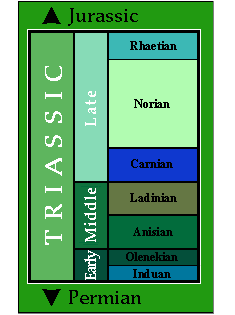
Events marking the beginning and end of the geologic period
End of Permian/Beginning of Triassic (248 mya):
- Pangaea begins to break apart as soon as it is completed
- mass Permian extinction
- extinction leads to opening of biological niches
End of Triassic/Beginning of Jurassic (202 mya):
- terminal Triassic extinctions
- both marine and terrestrial communities highly affected
Ecological Communities/Climate
Vast marine and reptilian communities.
Ferns, cycads, ginkgos, conifers, and scouring rushes also dominate the landscape.
Many evolutionary firsts:
- oyster
- dinosaur
- crocodile
- turtle
- frog
- salamander
- mammal
Generally warm, dry climate
Sea levels reached an all time low at the beginning of the Triassic, but then rose steadily into
the late Triassic, when they dropped again.
Oxygen levels only made up about 15% of the atmosphere during the early Triassic.
They rose during the middle to 19%, only to drop back down to 15% at the end of the period.
Compare these levels to today's oxygen levels of 21%.
Continental drift and climate
At the beginning of the Triassic period, Pangaea is still intact.
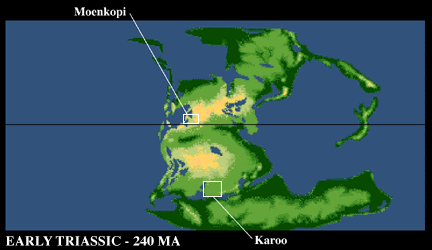
It begins to break apart in the mid-Triassic:
- Gondwana (South America, Africa, India, Antarctica, and Australia) is formed in the south
- Laurasia (North America and Eurasia) is formed in the north
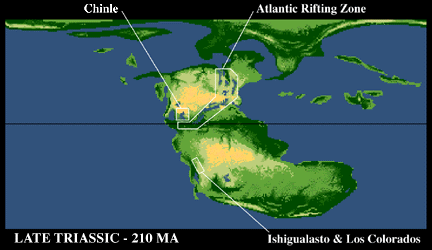
The movement of the two resulting supercontinents was caused by sea floor spreading at the
midocean ridge lying at the bottom of the Tethys Sea. While Pangaea was breaking apart,
mountains were forming
on the west coast of North America from Alaska to Chile by subduction of the ocean
plates beneath the continental plates. Concurrently, North Africa was being split from Europe
by the spreading rift.
This division of the continents advanced further westward, eventually
splitting eastern North America from North Africa.
The climate of the Triassic era was definitely influenced by Pangaea:
- (1)Flooding of
the continents to form shallow seas did not occur due to low sea levels
- (2)Much of the inland area was isolated from the
cooling and moist effects of the ocean
Global results:
- Arid
and dry climate
- No polar ice caps
REGIONAL CLIMATES:
- Presence of coal-rich sequences in the high
northern and southern latitudes, as well as the presence of large amphibians there, indicate that
the climate was wetter in those areas.
- In addition to deserts, areas of low-growing vegetation abound in the middle latitudes, including
savannas or
fern prairies with dry, nutrient poor soil.
Adaptive radiations
MARINE RADIATIONS
So many ecological niches opened up after the terminal Permian extinctions that there was a
complete reorganization of marine communities.
- BIVALVE MOLLUSCS radiate thanks to the evolution of the siphon.
- The single surviving genus of SEA URCHIN radiated to fill all empty niches at the end
of the Triassic and became three times as varied as they had been before the extinctions.
- The single surviving family of CRINOIDS gives rise to 5 orders of articulate crinoids,
including feather stars.
- Remaining CALCAREOUS SPONGES play an important role in reestablishing reefs in the Tethys Ocean.
- Siliceous HEXACTINELLID SPONGES undergo a 5 fold radiation in the Triassic.
- PRAWN, SHRIMP, LOBSTERS, and HERMIT CRABS also radiate.
TERRESTRIAL RADIATIONS and REPTILIAN DIVERSIFICATION
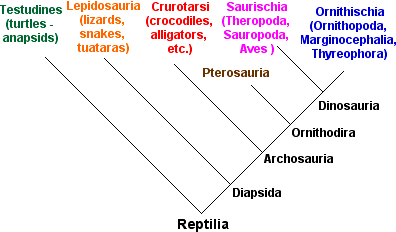
Archosaurs radiate.
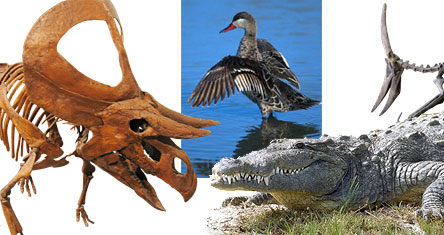
Flying reptiles evolve. Pterosaurs are introduced during the Triassic --- warm-blooded creatures
with big brains and keen eyesight.
Dinosaurs emerge as well. They advance over the thecodonts by the evolution of longer hind legs,
which increase their running speed by 50%.
Two major groups develop:
- SAURISCHIANS (lizard hipped): earliest dinosaurs with pelvic bones like thecodonts --- both
herbivorous and carnivorous
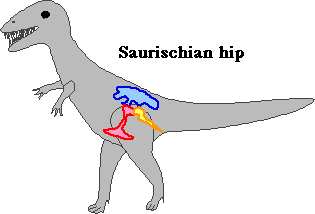
- ORNITHISCHIANS (bird hipped): bird-like pelvis which provides new, stronger rearward pull of
the leg muscles --- herbivorous
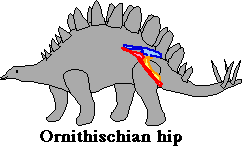
Mammals originate. Cynodonts, small, mammal-like creatures, survive the Permian. They give rise
to the earliest
mammal family, the Morganucodontids. Earliest mammals are insect feeders and very small, with a
skull length of 25-35 mm.
 Extinctions
Extinctions
MARINE EXTINCTIONS
- 84% survival rate for families of marine organisms
- 4 groups of molluscs disappear completely
- Coiled snails/bellerophontides survive the Permian, but not the Triassic
- Ceratites disappear
TERRESTRIAL EXTINCTIONS
- more severe than the marine extinctions
- all but 1 (out of 5) family of amphibians go extinct
- thecodonts disappear, allowing dinosaurs to become the dominant terrestrial forms
- Pterodactyls, crocodiles, and dinosaurs are the only descendants of thecodonts to survive
- of all the mammal-like reptiles, only 1 form of herbivorous cynodonts survive,
as do 3 families of mammals
POSSIBLE CAUSES
Causes of the terminal Triassic extinctions are not well understood. Disappearance of shallow
marine life
may be due to falling sea levels, which lowered the available habitats open to these organisms.
An asteroid impacting the environment is another possible cause, but the fact that there is no
evidence
for one hitting the earth at the late Triassic/ early Jurassic time boundary greatly limits
this hypothesis.
Fossil resources
The Triassic generally has a sparse fossil record, but fossils can be found in the
following locations:
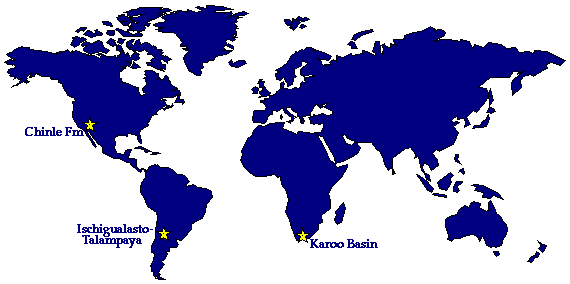
- Arizona
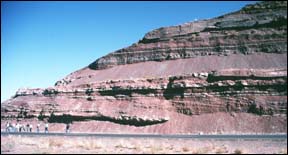
Exposure of red beds of the Moenkopi Formation along Interstate
40 near Winslow, Arizona.
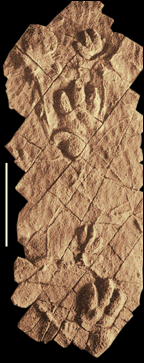
The footprint of an archosauriform
- Ischigualasto, Argentina - The best-known and best-preserved early dinosaurs come from
this locality in South America.
- Karoo Basin, South Africa - rich in synapsid bones
The Argentina site is also the only place in the world where nearly all of the Triassic
is represented in an
undisturbed sequence of rock deposits. Both
the overlying and underlying formations have also yielded important fossils of early dinosaurs as
well as of early synapsids and freshwater fish. Fossil ferns and horsetails
have also been found.
Literature cited
Condie, Kent C. and Robert E. Sloan. Origin and Evolution of Earth. Prentice Hall, 1998.
Cooper, John D. et al. A Trip Through Time. Merrill, 1986.
Dott, Robert H. and Roger L. Batten. Evolution of the Earth. McGraw-Hill, 1988.
Links to other sites







